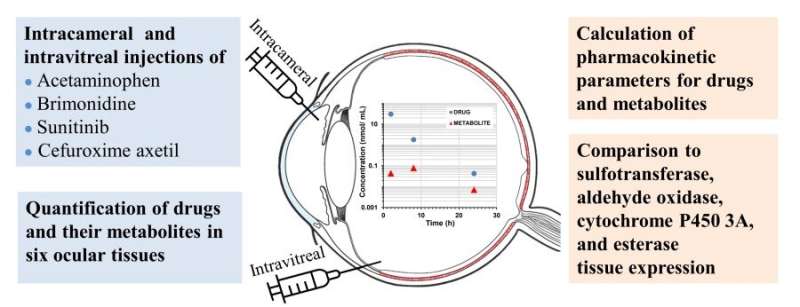New data on drug metabolism and distribution in the eye

Severe visual illnesses are increasing in our society, and effective treatments are missing for diseases as age-related macular degeneration, diabetic retinopathy, and glaucoma. Both industry and academia are highly interested to advance ocular drug discovery and development. Ocular pharmacokinetics is a key science in this process, and knowledge of drug metabolism and distribution in the eye is required. However, information on drug-metabolizing enzymes is only sparsely available and new insights in this field will benefit the current and future development of ocular therapies.
Researchers from the School of Pharmacy at the University of Eastern Finland in collaboration with Boehringer Ingelheim have recently published one of the most comprehensive ocular pharmacokinetic studies that investigated the metabolism of four drugs in the rabbit eye (acetaminophen, brimonidine, cefuroxime axetil, sunitinib). The drugs were applied via two administration routes (intracameral and intravitreal) and concentrations of both parent drug and the main metabolite were analyzed in six different ocular tissues. Finally, pharmacokinetic drug and metabolite profiles were obtained and analyzed.
Ocular drug metabolism cannot be directly predicted from hepatic metabolism data
The metabolism of a drug is usually assessed based on its behavior in the liver. However, this study showed that activities for many metabolic enzymes are low in the ocular tissues and their profiles are different from those in the liver. Thus, ocular metabolism cannot be directly predicted from the hepatic metabolism data that are generally produced during drug development. Only esterases seem to have a major impact on ocular drug clearance and not the other enzymes. However, the latter may contribute to ocular drug toxicity especially important for long-acting drug formulations. In conclusion, the present study provides valuable and drug-specific information on ocular drug metabolism and pharmacokinetics for advancing ophthalmic drug development.
More information: Eva M. del Amo et al, Ocular metabolism and distribution of drugs in the rabbit eye: Quantitative assessment after intracameral and intravitreal administrations, International Journal of Pharmaceutics (2021). DOI: 10.1016/j.ijpharm.2021.121361




















